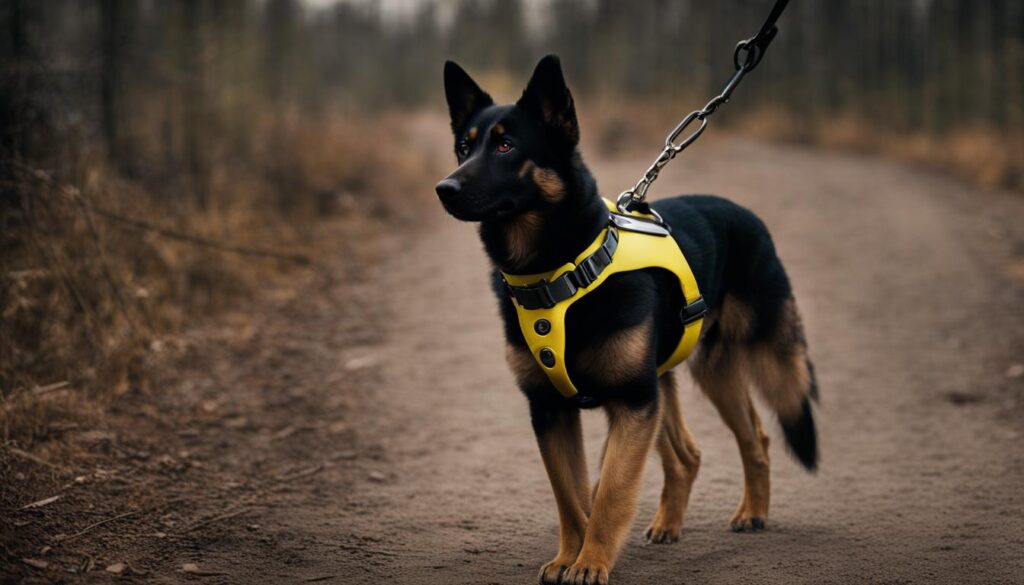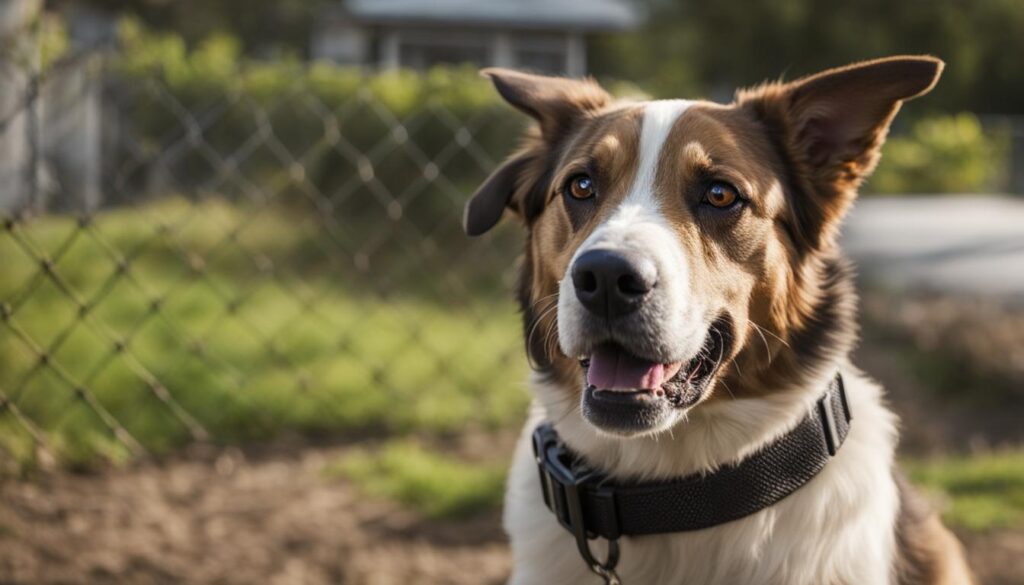Welcome to our comprehensive guide on dog care and the proper usage of shock collars. Shock collars, also known as electronic collars or e-collars, are devices designed to assist in dog training. In this guide, we will explore the various aspects of shock collar usage, focusing on effective and safe techniques to enhance obedience in your furry friend.
- Understanding Shock Collar Components and Package Content
- Setting Up the Shock Collar
- Exploring Training Modes
- Properly Fitting the Receiver Collar
- Training Tips for Using a Shock Collar
- Important Safety Considerations
- Troubleshooting and Maintenance
- Operating Environment and Care
- Product Specifications
- Conclusion
- FAQ
- Source Links
Key Takeaways:
- Shock collars are electronic devices used in dog training to enhance obedience.
- Properly fitting the receiver collar is essential for optimal performance.
- Training should involve positive reinforcement techniques in conjunction with the shock collar.
- Safety considerations, such as avoiding overcorrection and using the collar as a supplementary corrective stimulus, are crucial.
- Consulting a professional trainer is recommended for any concerns or aggressive behavior.
Understanding Shock Collar Components and Package Content
In order to effectively use a shock collar for dog care and training, it is important to understand its components and what is included in the package. Shock collars typically consist of a remote control and a receiver collar. The remote control allows you to control the level of stimulation that is emitted to the dog’s neck through the receiver collar. This gives you the ability to tailor the training to your dog’s specific needs and behavior. It is important to note that shock collars should only be used as a training tool and not as a means of punishment.
The package content of a shock collar may vary depending on the brand and model, but it often includes additional accessories to enhance usability. These accessories may include a USB cable for charging the collar and remote control, a lanyard for easy carrying, and a user manual with instructions on how to properly use and maintain the shock collar. It is important to carefully read and follow the user manual to ensure the safe and effective use of the shock collar.
| Component | Description |
|---|---|
| Remote Control | The device used to control the level of stimulation emitted by the shock collar. |
| Receiver Collar | The collar worn by the dog that receives the electronic pulses. |
| USB Cable | Used to charge the shock collar and remote control. |
| Lanyard | A strap or cord attached to the remote control for easy carrying. |
| User Manual | A guide that provides instructions on how to properly use and maintain the shock collar. |
By understanding the components and package content of a shock collar, you can ensure that you have all the necessary tools to effectively train your dog and enhance obedience.
Setting Up the Shock Collar
Before you can start using the shock collar for training your dog, it is important to properly set it up. Following the instructions provided in the user manual, you’ll need to charge both the remote control and the receiver collar. Make sure to charge the remote control until the battery indicator on the display shows full bars. Similarly, charge the receiver collar until the LED turns green, indicating that it is fully charged and ready to use.
To ensure effective communication between the remote control and the receiver collar, it is crucial to match or pair them correctly. This process is typically straightforward and involves following the step-by-step instructions provided in the user manual. Once paired, the remote control will be able to transmit signals and commands to the receiver collar, allowing you to control the level of stimulation for your dog’s training.
Pairing the Remote Control and the Receiver Collar
If you are unsure about how to pair the remote control and the receiver collar, here are some general steps to guide you through the process:
- Make sure both the remote control and the receiver collar are fully charged.
- Power on the remote control and the receiver collar.
- Press and hold the pairing button on the receiver collar until the indicator light starts flashing.
- Press the corresponding button on the remote control to send a signal to the receiver collar.
- Wait for the indicator light on the receiver collar to stop flashing and remain solid, indicating successful pairing.
- Test the communication between the remote control and the receiver collar by pressing the stimulation buttons and ensuring that the receiver collar responds accordingly.
Once the shock collar is properly set up, you are ready to embark on your dog’s training journey. Remember to always use the shock collar responsibly and in conjunction with positive reinforcement techniques to ensure the safety and well-being of your furry friend.
Exploring Training Modes
When it comes to training your dog using a shock collar, understanding the different training modes is crucial. These modes provide various ways to communicate with your dog and reinforce certain behaviors. Let’s take a closer look at the three main training modes commonly found in shock collars:
Vibration Mode
In vibration mode, the shock collar delivers a single vibration to get your dog’s attention. This mode is often used as a precursor to static stimulation, allowing you to redirect your dog’s focus or signal a command without using a stronger stimulus. It can be an effective way to communicate with your dog in a gentle manner.
Sound Mode
In sound mode, the shock collar emits a beep sound to get your dog’s attention. Similar to vibration mode, sound mode is often used as a warning or as a signal for a specific command. This mode works well for dogs that are more sensitive to audio cues or for situations where a vibration may not be appropriate or effective.
Static Stimulation Mode
Static stimulation mode, also known as the shock mode, delivers a mild electric shock to your dog. The intensity of the shock can usually be adjusted to suit your dog’s temperament and responsiveness. It is important to use this mode responsibly and only when necessary, as continuous or prolonged shock can be harmful to the dog. Static stimulation should be used as a last resort for correcting undesirable behaviors.
Remember, when using a shock collar, it is crucial to prioritize your dog’s well-being and safety. Always use positive reinforcement techniques in conjunction with the shock collar, and consult with a professional trainer if you have any concerns or need guidance on how to best use the training modes.
| Training Mode | Usage | Effectiveness |
|---|---|---|
| Vibration Mode | Redirecting attention, signaling commands | Effective for gentle communication |
| Sound Mode | Warning, audio cues, specific commands | Works well for audio-sensitive dogs |
| Static Stimulation Mode | Correcting undesirable behaviors | Use responsibly, as a last resort |
Properly Fitting the Receiver Collar
When using a shock collar for dog training, it is crucial to ensure that the receiver collar is properly fitted on your dog’s neck. This ensures both comfort and effectiveness during training sessions. Here’s a step-by-step guide on how to properly fit the receiver collar:
- Make sure the collar is snug: The receiver collar should be snug on your dog’s neck, but not too tight. It should fit comfortably without causing any discomfort or restrictions in movement.
- Position it high on the neck: Place the receiver collar high on your dog’s neck, just below the ears. This allows for better communication between the collar and your dog’s vocal cords, ensuring clear signals are transmitted.
- Separate the fur: To ensure optimal contact between the metal electrodes on the collar and your dog’s skin, separate the fur around the neck area. This ensures that the electrodes make direct contact with the skin, allowing for effective stimulation.
It is important to note that the receiver collar should not be worn for more than 12 hours at a time. This helps prevent any discomfort or skin irritation that may occur from prolonged use. Regularly check your dog’s neck for any signs of irritation or redness, and give your furry friend breaks from wearing the collar as needed.
By properly fitting the receiver collar, you can ensure that your dog receives effective and safe training sessions. Remember to always follow the manufacturer’s instructions for your specific shock collar model and prioritize your dog’s comfort and well-being throughout the training process.
Table: Shock Collar Fitting Guide
| Steps | Instructions |
|---|---|
| Step 1 | Ensure the collar is snug on the dog’s neck, not too tight. |
| Step 2 | Position the collar high on the neck, just below the ears. |
| Step 3 | Separate the fur to ensure direct contact between the electrodes and the dog’s skin. |
Training Tips for Using a Shock Collar
When using a shock collar for training, it is important to follow some important tips. These tips will help you maximize the effectiveness of the collar while ensuring the safety and well-being of your dog. Here are some key training tips to keep in mind:
- Use positive reinforcement techniques: While the shock collar can be an effective tool, it should always be used in conjunction with positive reinforcement techniques. Reward your dog with treats, praise, and affection when they exhibit the desired behavior. This will help your dog associate positive experiences with the training process.
- Avoid overcorrection: It is essential to use the shock collar judiciously and avoid overcorrecting your dog. Use the lowest possible stimulation level necessary to get your dog’s attention and make sure the collar is adjusted to the appropriate intensity for your dog’s size and temperament.
- Be consistent with verbal commands: Consistency is key when using a shock collar. Use clear and concise verbal commands in conjunction with the collar to reinforce the desired behavior. Make sure everyone in your household uses the same commands to avoid confusion for your dog.
“Positive reinforcement techniques and consistency are key when using a shock collar for training.”
It is important to note that while shock collars can be effective training tools, they should not be relied upon as the sole method of training. Professional guidance and support can be immensely helpful in ensuring that you are using the shock collar appropriately and addressing any behavioral issues that may arise. By following these training tips and seeking professional help when needed, you can effectively train your dog using a shock collar while prioritizing their well-being and safety.
Important Safety Considerations
When using a shock collar for dog training, it is essential to prioritize safety and follow important guidelines. By taking necessary precautions, you can ensure the well-being and comfort of your furry friend throughout the training process.

Age and Health Considerations
Shock collars should not be used on dogs below the age of 6 months. Younger puppies have more sensitive necks and may not respond well to the stimulation. Additionally, if your dog has any health issues or conditions, it is important to consult with a veterinarian before using a shock collar to ensure it is safe for them.
Proper Training Techniques
Using a shock collar should be part of a comprehensive training program that includes positive reinforcement techniques. It is important to avoid relying solely on the shock collar for training and to use it as a supplementary corrective stimulus. Verbal commands should always be used first, and the shock collar should only be used when absolutely necessary.
Building Trust and Positive Association
It is crucial to build trust and maintain a positive association with the shock collar. This can be done by pairing the collar with rewards, such as treats or praise, during training sessions. By associating the collar with positive experiences, your dog will be more willing to respond to commands and less likely to develop fear or anxiety related to the collar.
Professional Guidance
If you have any concerns or issues arise during the training process, it is recommended to seek guidance from a professional dog trainer. They can provide personalized advice and techniques to ensure effective and safe training with the shock collar.
Conclusion
Remember, the well-being and safety of your dog should always be the top priority when using a shock collar. By following the proper safety considerations and using the collar responsibly, you can enhance obedience and strengthen the bond with your furry companion.
Troubleshooting and Maintenance
Ensuring the proper functioning of your shock collar is essential for effective dog training. In this section, we will discuss troubleshooting steps and maintenance tips to keep your collar in optimal condition.
Troubleshooting
If you encounter any issues with your shock collar, there are a few steps you can take to troubleshoot the problem. First, check the battery connection on both the remote control and receiver collar. Make sure they are securely connected and properly inserted.
If the collar is not responding to the remote control, ensure that the batteries are charged and that you are within the operational range. If the problem persists, consult the user manual or contact customer support for further assistance.
Maintenance
Regular maintenance of your shock collar is important to ensure its longevity and functionality. Take the time to clean the collar and remote control regularly using a mild detergent and a soft cloth. Avoid using harsh chemicals or abrasive materials, as they can damage the devices.
Additionally, inspect the collar and prongs for any signs of wear or damage. If you notice any cracks or broken parts, it may be necessary to replace them to prevent injury or discomfort to your dog. Regularly check the battery life and replace them as needed to ensure uninterrupted training sessions.
| Maintenance Tips | Frequency |
|---|---|
| Clean the collar and remote control | Once a week |
| Inspect for wear or damage | Once a month |
| Check battery life | Regularly |
By following these troubleshooting steps and maintenance tips, you can ensure that your shock collar remains in optimal condition, allowing you to train your dog effectively and safely.
Operating Environment and Care
When using a shock collar for dog care, it is important to consider the operating environment and take appropriate care of the device. Here are some essential guidelines to ensure the safe and effective use of the collar:
- Avoid exposing the shock collar to extreme temperatures, as it may affect its functionality. Keep it away from excessive heat or cold.
- Protect the shock collar from water or moisture. Do not submerge it or use it in wet conditions.
- Avoid using the shock collar in places with strong electromagnetic interference, as it may interfere with the signal transmission and proper functioning of the device.
- Handle the shock collar with care and avoid dropping it, as it may cause damage to the components.
- Do not use the shock collar in corrosive environments, as it may lead to deterioration or malfunction.
- Regularly clean the shock collar with mild detergent to remove dirt or debris. Follow the manufacturer’s instructions for cleaning and maintenance.
- Store the shock collar in a safe and dry place when not in use, away from children or pets.
By following these guidelines, you can ensure the longevity and proper functioning of the shock collar, enhancing its effectiveness in dog training and behavior correction.
Remember, the shock collar is a tool to assist in training, and it should always be used responsibly and in conjunction with positive reinforcement techniques. Prioritize your dog’s well-being and safety throughout the training process.

Product Specifications
When choosing a shock collar for your dog, it is important to consider the product specifications to ensure it meets your training needs. Each shock collar model may have specific features and capabilities that can enhance the training process. Here are some key specifications to look for:
- Range of the Remote Control: The range of the remote control determines how far away you can be from your dog while still being able to control the collar. Look for a shock collar with a range that suits your training environment.
- Number of Stimulation Levels: Different dogs may require different levels of stimulation for effective training. A shock collar with multiple stimulation levels allows you to adjust the intensity based on your dog’s response.
- Type of Batteries Used: Consider the type of batteries used in the shock collar, as this will affect the convenience and cost of maintenance. Some collars use rechargeable batteries, while others require standard replaceable batteries.
These specifications can vary depending on the manufacturer and model of the shock collar. It is important to read product descriptions and reviews to ensure the collar meets your specific training requirements.
Remember, while shock collars can be effective tools for training, it is essential to prioritize your dog’s well-being and safety. Always use the collar responsibly and in conjunction with positive reinforcement techniques. If you have any concerns or questions about using a shock collar, consult a professional trainer for guidance.
| Specification | Description |
|---|---|
| Range of the Remote Control | Determines the distance from which you can control the shock collar. |
| Number of Stimulation Levels | Allows you to adjust the intensity of the stimulation based on your dog’s response. |
| Type of Batteries Used | Considers whether the collar uses rechargeable or replaceable batteries. |
Conclusion
Shock collars can be effective tools for training dogs when used properly and responsibly. They provide a means of enhancing obedience and ensuring the safety of your furry companion. However, it is crucial to prioritize the well-being and overall care of the dog throughout the training process.
When utilizing a shock collar, it is important to remember that positive reinforcement techniques should be used in conjunction with the collar. This means praising and rewarding your dog for good behavior, rather than relying solely on the collar for correction. By combining positive reinforcement and the use of a shock collar, you can create a balanced and effective training approach.
If you have any concerns or difficulties during the training process, we highly recommend seeking professional guidance. An experienced dog trainer will have the knowledge and expertise to provide specific advice tailored to your dog’s individual needs. They can offer insights on how to properly use the shock collar and address any aggressive behavior or negative reactions that may arise.
Remember, the goal of dog care shock collar usage is not to cause harm or discomfort to your pet. It is to provide a means of communication and reinforcement that facilitates obedience and enhances the bond between you and your furry friend. With proper training, care, and consideration for your dog’s well-being, shock collars can be a valuable tool in your dog training journey.
FAQ
What is a shock collar?
A shock collar, also known as an electronic collar or e-collar, is a device used for dog training. It emits an electronic pulse to the dog’s neck through small prongs on the collar.
What are the components of a shock collar?
A shock collar typically consists of a remote control and a receiver collar. The remote control allows the owner to control the level of stimulation, while the receiver collar is worn by the dog. Some packages may also include additional accessories such as a USB cable, lanyard, and user manual.
How do I set up a shock collar?
To set up a shock collar, you need to charge both the remote control and receiver collar. The collar and control should also be matched or paired, following the instructions in the user manual.
What training modes does a shock collar offer?
A shock collar typically offers vibration mode, sound mode, and static stimulation mode. Vibration mode produces a single vibration, sound mode emits a beep sound, and static stimulation mode delivers a mild electric shock to the dog.
How should the receiver collar be fitted on the dog’s neck?
The receiver collar should be positioned high on the dog’s neck, near the ears, and should be snug. It is important to separate the fur and ensure that the metal electrodes are in contact with the dog’s skin.
What tips should I follow when using a shock collar for training?
Some important tips to follow include using positive reinforcement techniques, avoiding overcorrection, and being consistent with verbal commands. It is also crucial to avoid relying solely on the shock collar and to consult a professional trainer if any negative reactions are observed.
How can I ensure the safety of my dog when using a shock collar?
Safety can be ensured by following the manufacturer’s instructions and guidelines, using the collar as a supplementary corrective stimulus, and not using the collar on dogs below the age of 6 months or on dogs with health issues.
What should I do in case of issues with the shock collar?
In case of issues, you should follow troubleshooting steps such as checking the battery connection and ensuring proper charging. You can also contact customer support if necessary.
How should I care for the shock collar?
Regular maintenance, such as cleaning the collar and remote with mild detergent, is recommended. It is also important to avoid extreme temperatures, water exposure, and operating in places with strong electromagnetic interference.
What are the product specifications of a shock collar?
Each shock collar model may have specific specifications such as the range of the remote control, the number of stimulation levels, and the type of batteries used. It is important to review the specifications for the specific shock collar being used.
Are shock collars effective for dog training?
When used properly and responsibly, shock collars can be effective tools for training dogs. However, it is crucial to prioritize the well-being and safety of the dog during the training process and to use positive reinforcement techniques in conjunction with the shock collar.




